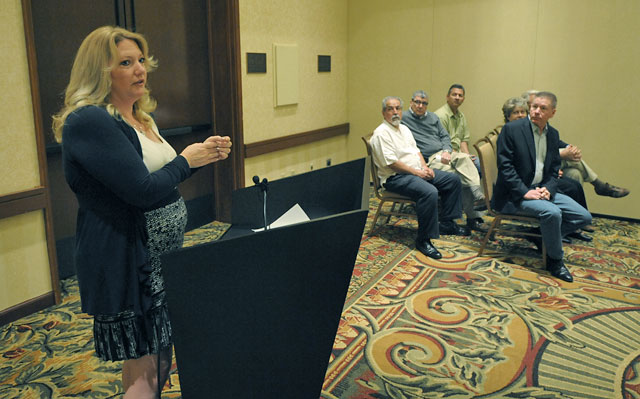Paradigms Lost and Found
Where Right Meets Left on Homelessness

Adding another incongruous twist to Santa Barbara’s ongoing debate over homelessness, members of the City Council’s conservative block said they and their colleagues should look to Santa Monica — a city so liberal it’s known as “The People’s Republic of Santa Monica” — for guidance on getting homeless people off the streets. Councilmembers Michael Self, Dale Francisco, and Frank Hotchkiss called for a “paradigm shift” in the way Santa Barbara responds to homelessness at a press conference called by the Milpas Community Association (MCA) last Friday. They praised Santa Monica for its data-driven, results-based, and in-your-face assertive manner in dealing with the homeless population, claiming this approach has resulted in a 25-percent reduction in the number of street people there. It should not be about the number of homeless served, the councilmembers stated; it’s about the number of homeless people gotten off the streets. “We are not here to sustain homelessness,” declared Councilmember Self. Sharon Byrne, MCA’s director, called on City Hall to display the political will needed “to abandon a model of enabling.” The press conference came just a few days after Byrne and the MCA took three councilmembers, two cops, City Attorney Steve Wiley, and Community Development Director Paul Casey on a field trip to Santa Monica, where they met with the mayor and other city officials dealing with homelessness.
In the past four years, Santa Monica has adopted a series of ordinances that effectively bars panhandling on Santa Monica’s Third Street Promenade, bans RV parking of any kind, and prohibits food distribution to the homeless in city parks. In addition, Santa Monica has taken a more aggressive enforcement posture toward liquor stores and convenience stores who sell alcohol to inebriated street people. All that’s been coupled by a focused effort by city officials to keep constant track of the homeless in Santa Monica, determine what services they need, and make sure they get them. People who turn down such services are not left alone in Santa Monica. City Hall employees there take pains to reunite the homeless with their families and have found housing for the chronically homeless who’ve placed the greatest drain on limited public resources.
Mayor Helene Schneider, who has worked on homeless issues for years, praised the group conducting independent research, but said, “The paradigm shift happened here four years ago.” Many of the things Santa Monica is doing, she said, Santa Barbara is also doing. For example, Casa Esperanza manages to reunite about five guests a month with their families. And in 2009, permanent housing was secured for about 380 shelter residents who might otherwise find themselves caught in the expensive revolving door between the streets, the County Jail, and the emergency room. In addition, a campaign has been launched to target homeless people upon their arrival in County Jail, identify their needs, and see to it that they got somewhere safe upon their release.
But there are big differences, too. In Santa Monica, there’s practically a department of homeless services at City Hall. Six cops and four outreach workers — on Santa Monica’s city payroll — are assigned to work exclusively on homelessness. In Santa Barbara, one officer is assigned to restorative policing full-time and the Casa Esperanza shelter employs two outreach workers six hours a day. Continued funding for those outreach workers, however, remains in doubt. Also, Santa Monica — physically smaller and more geographically compact than Santa Barbara — has a tax base more than twice the size of Santa Barbara’s. City voters there endorsed a half-cent sales tax increase to fund human services. Santa Monica gives out $7.2 million every year to nonprofits dealing with the poor; Santa Barbara distributes $1.2 million.
In Santa Barbara, it’s been the nonprofit community, rather than government, that took the lead advocating for a more strategically focused — and coordinated — distribution of resources when dealing with the homeless. The “Bringing Our Community Home” coalition was formed to do just that, but its focus has been countywide, not Santa Barbara city-centric. The group’s efforts have been hampered by the economic downturn. Nor has it helped that its first two directors confronted serious health challenges that limited the time and energy they could devote. Now, the group is run by the tag-team of Mike Foley and Sylvia Bernard, who already have full-time jobs running Casa Esperanza and Good Samaritan homeless shelters, respectively.
While MCA members have taken pains to praise Foley, many have attributed the large number of homeless along the Milpas corridor to the nearby shelter; others have suggested that the Casa’s free lunch program is an attractive nuisance and should be stopped. Foley noted that in Santa Monica, such feeding programs were deliberately brought inside when the powers-that-be banned feeding programs in the parks. Likewise, Foley found it ironic that Casa’s critics would support the Santa Monica approach, where some shelters allow drunk people and their alcohol as part of a strategy to reach “the service-resistant.” Foley also noted that he’s been clamoring for the hard data upon which to base data-driven policies and allocation of resources for the past six years. “If that’s what they’re asking for, too,” he said, “I say welcome to the club.”



